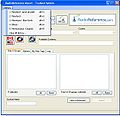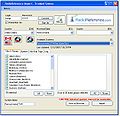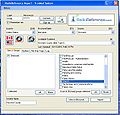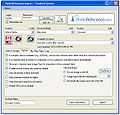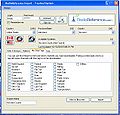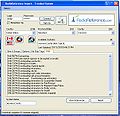Difference between revisions of "Freescan RR Trunk Import"
From The RadioReference Wiki
| (49 intermediate revisions by 3 users not shown) | |||
| Line 1: | Line 1: | ||
<gallery> | <gallery> | ||
| − | Image: | + | Image:FS RR Import conv pulldown.JPG|Figure 1 |
| − | Image:RR | + | Image:FS RR trunk import1 v8.JPG|Figure 2 |
| − | Image:RR trunk | + | Image:FS warn untrackable.JPG|Figure 2A |
| − | Image:RR trunk | + | Image:FS RR trunk import3 v8.JPG|Figure 3 |
| − | Image:RR trunk | + | Image:FS RR trunk import2 v8.JPG|Figure 4 |
| + | Image:Trunk skip tags.JPG|Figure 5 | ||
| + | Image:FS RR trunk dbview.JPG|Figure 6 | ||
| + | Image:FS RR trunk complete v8.JPG|Figure 7 | ||
| + | Image:FS Trunk logs.JPG|Figure 8 | ||
</gallery> | </gallery> | ||
| − | |||
| − | |||
| − | |||
| − | |||
| − | |||
| − | |||
| − | ; | + | ''Click on the image to expand''<br> |
| − | + | ||
| − | + | #From the file pulldown select Import then RadioReference Trunked (figure 1). For a moment, your subscription expiration date will flash on the left lower corner of the form | |
| − | + | # To begin the process; | |
| − | + | ##If you are online and wish to use the RR web service, enter your RadioReference Userid and Password and hit 'Connect'. Note that once you are signed on, you can use the History pulldown to return to a previously-utilized RR site. Note the hotkeys are accessed with ALT and a number (figure 2). | |
| − | + | ##RR CD ROM support has been removed as of version 2.10 | |
| − | + | # Once you have hit 'Connect', select your home country from the pulldown. Under the country name there are flags for the US or Canada; if you are importing from either of these countries, click on the appropriate flag, then hit the 'Save Present Location' button to the left of 'Available Systems'. If you need to recall the location again, use the 'Recall my Home Location' button immediately to the right of the Canadian flag. | |
| − | + | #Select the state or province from the 'Province/State' pulldown. Wait for the counties are populated - a number will show up on the right top side of the 'county' pulldown | |
| + | #Select the desired county from the 'county' pulldown. A number next to the 'Available System' title to the right will show the number of systems available. | ||
| + | #Select the desired system from the 'Available System' pulldown. | ||
| + | ##FS will warn you if you try to import a system that cannot be scanned. These are systems that utilize protocols that are not supported by the current scanner technology. These include Open Sky, NexEdge and IDEN systems. LTR Multinet, LTR Passport and MPT-1327 systems are (incorrectly) flagged with this warning (these can be scanned conventionally but not trunked). | ||
| + | #Figure 3 shows a populated screen with sites and groups. To select only some sites, hit the 'None' button, then '''double click''' the site you wish to import. The same logic works on the group screen on the right. | ||
| + | #Figure 4 shows the available options. | ||
| + | ##If you wish to utilize the [[Control Channel Only]] mode, make sure the box next to 'Enable' is checked. This is only valid on Motorola systems, and is the '''default''' for P25 systems. These systems are defined as ''APCO-25 Common Air Interface Exclusive'' in the RadioReference database. You '''must''' download all channels, in the correct [[LCN]] order, for LTR and EDACS systems. | ||
| + | ##You can select "Only Download control channels" to download only primary and alternate control channels (marked in {{color|red|red}} and {{color|blue|blue}} in the Radioreference database, respectively). | ||
| + | ##If you are downloading a trunk system defined as ''Analog and APCO-25 Common Air Interface'' in the RadioReference database to an analog trunktracker (not a BCD396, BCD396XT, BCD996T, BCD996XT) checking the Skip Digital box will skip those talkgroups defined as digital in the mode column. | ||
| + | ##There are no scanners currently available that can handle encrypted systems; so it's advisable to turn that option on. | ||
| + | ##Be sure to decide whether you wish to hard code a quick key, let FS find the next free one (press the 'Find Free' button) or not allocate at all. If you don't allocate a quick key, you will need to do so on the group screen. | ||
| + | ##If you wish to download the GPS information for use in the scanner, or to use the Google plotter (see [[Freescan Tools functions|Tools/GPS System Plotter]]) be sure to check the 'Enable GPS use by default' button | ||
| + | #You can cause the import to ignore talkgroups with specific tags. '''Double Click''' the name you wish to ignore and talkgroups with these tags will be suppressed (figure 5). Single clicking the name resets the selection. Note that if you are using the RR CD Import, this function is not available | ||
| + | #If you wish to view the entry on the RadioReference database, click the 'View in Browser' button. An example of the result is shown in figure 6 | ||
| + | #When you are satisfied, click on 'Import'. The system, along with all available frequencies and talkgroups will be imported. It is the user's responsibility to validate the options are all set as desired, and that all quick keys are '''allocated and enabled''' (figure 7). | ||
| + | #When available, coordinates from RR Web service are imported as well. Be sure to enable the use of this function on the system screen | ||
| + | ## Site notes from the RR Web service are now imported along with the system. When you click on a site, the associated note will appear under the site settings. | ||
| + | ## Bandplans for trunk sites importing from RR are now handled on a per-site basis versus a per system basis. This is to accommodate the new systems that have different bandplans for different towers. | ||
| + | ## All RR Web service messages are now logged. See Figure 8 | ||
| + | #See the [[Freescan Tips|Tips]] article for important information on limits and known issues | ||
| + | |||
| + | |||
| + | ==TGID Expander== | ||
| + | FreeScan also has a function called '''TG Expander'''. This works in the following manner; FreeScan stores all the talkgroup information in memory, even if there are more talkgroups than the scanner can actually store. Even if you run the scanner in ID SEARCH mode, FreeScan will examine memory to find the alpha tag for the appropriate talkgroup. | ||
Return to the [[FreeScan User Guide]] | Return to the [[FreeScan User Guide]] | ||
| − | [[Category: | + | [[Category:FreeSCAN]] |
Latest revision as of 19:21, 6 January 2014
Click on the image to expand
- From the file pulldown select Import then RadioReference Trunked (figure 1). For a moment, your subscription expiration date will flash on the left lower corner of the form
- To begin the process;
- If you are online and wish to use the RR web service, enter your RadioReference Userid and Password and hit 'Connect'. Note that once you are signed on, you can use the History pulldown to return to a previously-utilized RR site. Note the hotkeys are accessed with ALT and a number (figure 2).
- RR CD ROM support has been removed as of version 2.10
- Once you have hit 'Connect', select your home country from the pulldown. Under the country name there are flags for the US or Canada; if you are importing from either of these countries, click on the appropriate flag, then hit the 'Save Present Location' button to the left of 'Available Systems'. If you need to recall the location again, use the 'Recall my Home Location' button immediately to the right of the Canadian flag.
- Select the state or province from the 'Province/State' pulldown. Wait for the counties are populated - a number will show up on the right top side of the 'county' pulldown
- Select the desired county from the 'county' pulldown. A number next to the 'Available System' title to the right will show the number of systems available.
- Select the desired system from the 'Available System' pulldown.
- FS will warn you if you try to import a system that cannot be scanned. These are systems that utilize protocols that are not supported by the current scanner technology. These include Open Sky, NexEdge and IDEN systems. LTR Multinet, LTR Passport and MPT-1327 systems are (incorrectly) flagged with this warning (these can be scanned conventionally but not trunked).
- Figure 3 shows a populated screen with sites and groups. To select only some sites, hit the 'None' button, then double click the site you wish to import. The same logic works on the group screen on the right.
- Figure 4 shows the available options.
- If you wish to utilize the Control Channel Only mode, make sure the box next to 'Enable' is checked. This is only valid on Motorola systems, and is the default for P25 systems. These systems are defined as APCO-25 Common Air Interface Exclusive in the RadioReference database. You must download all channels, in the correct LCN order, for LTR and EDACS systems.
- You can select "Only Download control channels" to download only primary and alternate control channels (marked in red and blue in the Radioreference database, respectively).
- If you are downloading a trunk system defined as Analog and APCO-25 Common Air Interface in the RadioReference database to an analog trunktracker (not a BCD396, BCD396XT, BCD996T, BCD996XT) checking the Skip Digital box will skip those talkgroups defined as digital in the mode column.
- There are no scanners currently available that can handle encrypted systems; so it's advisable to turn that option on.
- Be sure to decide whether you wish to hard code a quick key, let FS find the next free one (press the 'Find Free' button) or not allocate at all. If you don't allocate a quick key, you will need to do so on the group screen.
- If you wish to download the GPS information for use in the scanner, or to use the Google plotter (see Tools/GPS System Plotter) be sure to check the 'Enable GPS use by default' button
- You can cause the import to ignore talkgroups with specific tags. Double Click the name you wish to ignore and talkgroups with these tags will be suppressed (figure 5). Single clicking the name resets the selection. Note that if you are using the RR CD Import, this function is not available
- If you wish to view the entry on the RadioReference database, click the 'View in Browser' button. An example of the result is shown in figure 6
- When you are satisfied, click on 'Import'. The system, along with all available frequencies and talkgroups will be imported. It is the user's responsibility to validate the options are all set as desired, and that all quick keys are allocated and enabled (figure 7).
- When available, coordinates from RR Web service are imported as well. Be sure to enable the use of this function on the system screen
- Site notes from the RR Web service are now imported along with the system. When you click on a site, the associated note will appear under the site settings.
- Bandplans for trunk sites importing from RR are now handled on a per-site basis versus a per system basis. This is to accommodate the new systems that have different bandplans for different towers.
- All RR Web service messages are now logged. See Figure 8
- See the Tips article for important information on limits and known issues
TGID Expander
FreeScan also has a function called TG Expander. This works in the following manner; FreeScan stores all the talkgroup information in memory, even if there are more talkgroups than the scanner can actually store. Even if you run the scanner in ID SEARCH mode, FreeScan will examine memory to find the alpha tag for the appropriate talkgroup.
Return to the FreeScan User Guide

